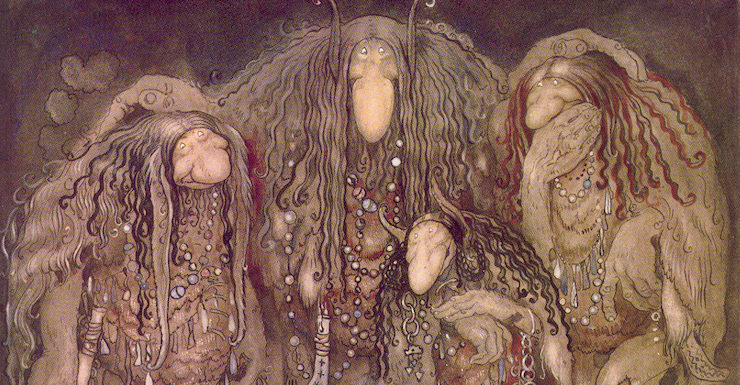On Christmas Eve, Santa shows up in Swedish homes to hand out Christmas presents. Of course, what it really is is an older family member in red clothes and a beard. Sometimes they wear a plastic Santa mask. When I was little, my grandfather played Santa. He showed up in a Santa mask, and I was terrified. It sort of looked like Grandpa, but I wasn’t sure those were his eyes behind the mask. Something was terribly wrong. My mother tells me I was terrified and cried until Grandpa took the mask off, and became himself again.
I’ve always been fascinated by the almost-human, and often return to it. I’m far from alone in my obsession. Folklore is full of humanoids with a strange or ominous agenda. There are Swedish creatures like the huldra woman, who lives in the forest and whose back is a rotten log. Some Swedish trolls look human but not quite: they’re taller and more beautiful, and sometimes you can spot a cow’s tail peeking out from under a skirt. In the 1950s and ’60s, the Grinning Man haunted lonely American highways, and Men in Black showed up in the wake of UFO flaps to ask nonsensical questions. In these creepypasta days, the Slenderman lurks at the edge of crowds and playgrounds, and black-eyed children knock on your door late at night and ask to be let inside. Centuries-old or modern, seen in real life or manufactured, these entities all have the same elements in common: they kind of look like us, but something is wrong, and they have strange agendas. It brings a very particular kind of fascination and fear to our minds.
Humans are really, really good at finding patterns in nature. Our survival has historically depended on quickly sorting things into categories: this is an animal you can cuddle, that one will probably eat you. These berries are edible, those are poisonous. It’s also the function that helpfully tells me that this person fulfills the criteria required to qualify as one of our group. If they don’t, if something is off, they are sorted as Other. And the Other is scary. It seems that the same goes for sorting beings into human and not-human. If an entity fulfills some of the criteria but not all of them, they are not-quite.
There are psychiatric states where the same kind of fear comes into play. The Capgras delusion is the belief that a close family member or friend has become replaced by an impostor. You recognize your loved one, but you fail to identify them as one of yours. The person is somehow alien, different. They’re not the same anymore. The fear of replacements echoes in folklore. In some of the modern creepypasta stories about the Goatman, people disappear into the forest. When they come back, something is off: they move differently, they struggle to perform basic tasks. It is as if they fail at being human. As if they have been replaced by impostors.
The fear of the almost-human is present in technology too, in the “uncanny valley” phenomenon: the state where a robot or other human-like construct has almost reached human resemblance, but not quite—at which point we react with revulsion. The robot has failed at humaning. The Men in Black fail at humaning, too: they knock on your door, dressed in archaic-looking suits, asking questions that seem nonsensical or weirdly intrusive. It can be said that clowns and mimes also fail: they have humanoid bodies, but their painted faces are impossible to read.
In my short story collection Jagannath, which is reissued this February, I have given this fear/fascination ample room. The impostor creature Pyret will try to look like one of us, insert itself into our community. What does it want? Nobody knows. The human-like vittra snatch people away to suit their murky purposes. A group of nebulous beings imitate Swedish midsummer feasts, down to the pickled herring. In my novel Amatka, I also touch on the subject: what can we become if we surpass our human limits? What does it even mean to be human? I keep picking at the theme like an inflamed cuticle. Why? Because everything that falls in between categories is interesting. Humans are very neurotic about it. As a human, I am neurotic about it. And picking at neuroses is fun. One of the items on my not-so-secret agenda is to make the reader rub up against the not-quite. To make friends with the strange. To widen the very narrow definition so many people have of what makes a human. In the current norm, it’s fairly easy to fail at humaning, even if you identify as one.
In one of the Goatman creepypastas, the main character hides in an outhouse while something walks around outside all night, calling out in a not-quite-human voice. Maybe it will be you hiding in the outhouse one day. Maybe you should open the door and have a look? Report back with your findings. I’ll be waiting. If you happen to be the one circling around the outhouse, I would love to hear from you too.
 Karin Tidbeck is originally from Stockholm, Sweden. She lives and works in Malmö as a freelance writer, translator, and creative-writing teacher, and writes fiction in Swedish and English. She debuted in 2010 with the Swedish short story collection Vem är Arvid Pekon? Her Crawford Award-winning short story collection Jagannath is available February 6th from Vintage.
Karin Tidbeck is originally from Stockholm, Sweden. She lives and works in Malmö as a freelance writer, translator, and creative-writing teacher, and writes fiction in Swedish and English. She debuted in 2010 with the Swedish short story collection Vem är Arvid Pekon? Her Crawford Award-winning short story collection Jagannath is available February 6th from Vintage.










